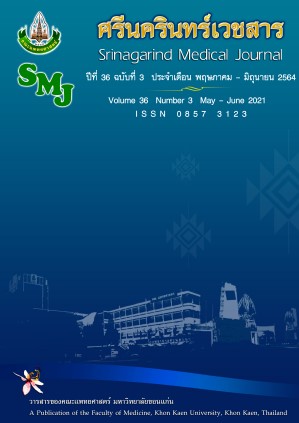การติดตามความสามารถในการทำกิจกรรมและการกลับไปทำงานในผู้ป่วยวัยแรงงานหลังได้รับการผ่าตัดเบี่ยงเบนหลอดเลือดหัวใจโคโรนารี่หรือผ่าตัดลิ้นหัวใจแล้ว 5 ปี
Abstract
บทคัดย่อ
หลักการและวัตถุประสงค์: กิจกรรมทางกายดีขึ้นและสามารถกลับไปทำงานได้ในวัยแรงงานเป็นเป้าหมายของการฟื้นฟูหลังผ่าตัดหัวใจระยะยาว ซึ่งไม่สามารถติดตามได้ต่อเนื่อง จึงติดตามทางไปรษณีย์ เพื่อ 1) เปรียบเทียบระดับกิจกรรม (Metabolic Equivalent; METs) จากแบบสอบถาม 12 กิจกรรม (Duke Activity Status Index,DASI) ระหว่างผู้ป่วยหลังผ่าตัดทำทางเบี่ยงหัวใจหรือลิ้นหัวใจแล้ว 5 ปี กับก่อนผ่าตัด 2) เปรียบเทียบ METs ของกลุ่มที่กลับไปทำงานและไม่ได้กลับไปทำงาน และ3) ศึกษา METs ในกลุ่มที่กลับไปทำงาน
วิธีการศึกษา:การศึกษาย้อนหลัง ในผู้ป่วยหลังผ่าตัดทำทางเบี่ยงหัวใจหรือลิ้นหัวใจ 5 ปี โดยเลือกจากเวชระเบียนศูนย์หัวใจสิริกิติ์ฯ ปี พ.ศ. 2555-2556 มีอายุ 15-60 ปีที่ประเมิน DASI ก่อนผ่าตัด โดยส่งแบบสอบถาม DASI และระดับความหนักเบาของการทำงานทางไปรษณีย์ จากนั้นวิเคราะห์ METs ที่ได้ด้วย SPSS
ผลการศึกษา: 1) METs หลังผ่าตัด 5 ปีเพิ่มขึ้น (p = 0.000) 2) METs ของกลุ่มที่กลับไปทำงานสูงกว่าอีกกลุ่ม (p = 0.024) 3) ในกลุ่มที่กลับไปทำงานพบ METs จาก DASI สูงกว่าในแบบสอบถามความหนักเบาของการทำงาน (p =0.00) และ METs จากความหนักเบาของการทำงานอยู่ในระดับปานกลางถึงหนัก
(5.55±1.72 METs)
สรุป: ผู้ป่วยผ่าตัดทำทางเบี่ยงหัวใจและเปลี่ยนลิ้นหัวใจมีกิจกรรมทางกายดีขึ้นหลังผ่าตัด 5 ปี โดยกลุ่มที่กลับไปทำงานมีกิจกรรมทางกายดีกว่าอีกกลุ่ม และมีความหนักของการทำงานระดับปานกลางถึงหนัก
คำสำคัญ การผ่าตัดทำทางเบี่ยงหัวใจ (CABG); ผ่าตัดลิ้นหัวใจ (Valvular Surgery); ระดับการทำกิจกรรม (METs: Metabolic Equivalent )
ABTRACTS
Background and Objectives: Improving functional activity and could return to work in labor age is the long term goal of post cardiac surgery rehabilitation.Long term follow up was discreted,therefore mail tracking is another option for 1) Comparison of Metabolic Equivalent (METs) from a 12-activity questionnaire (DASI) among patients of five years after CABG or valve surgery with pre-surgery 2) compared METs of the returning and no returned groups and 3) METs study was in return to work group.
Methods: Retrospective study in patients after CABG or valve surgery for 5 years. The samples were selected from QSHC medical record from 2012-2013, who were 15-60 years old that completed pre surgery DASI questionnaire. DASI and level of work questionnaire were sent by mail. The received METs was analyzed with SPSS program.
Results: 1) METs after 5 years of surgery were higher than before surgery (p = 0.000) 2) METs in the group that returned to work was higher than the no returned to work group (p = 0.024) 3) METs in the DASI questionnaire was higher than the METs in level of work questionnaire (p = 0.00). Returned to work 's METs from level of work questionnaire was moderate to heavy level (5.55 ± 1.72 METs).
Conclusions: Functional activity of CABG and valvular surgery patients increased from 5 years post surgery. The returned to work group was higher functional activity than those of the no returned group.The returning group had a moderate to heavy intensity level.
Keywords: CABG; Valvular Surgery; METs; Metabolic Equivalent


